JMP Live Help
Create visualizations with your data in JMP and share your analyses using JMP Live. Anyone viewing these posts has the interactive capabilities of JMP to explore your data.
Find out more about these topics:
Publish JMP Graphs and Reports as Posts
Publish your JMP graphs and reports to a JMP Live post. Create your graphs and reports in JMP and then click File > Publish. For more details, see Save and Share Reports.
Figure 1.1 JMP Live Post Thumbnails
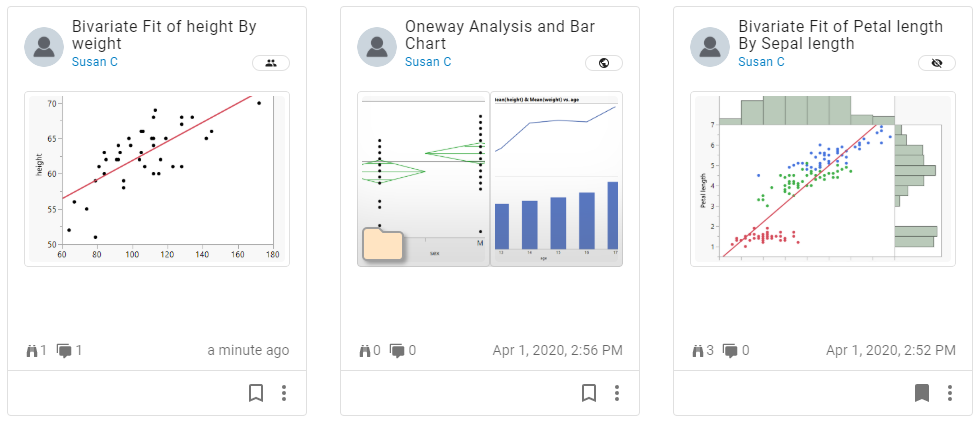
Icons indicate the following information:
|
|
The post is private (only you can see it)
|
|
|
The post is shared with everyone
|
|
|
The post is shared with groups
|
|
|
The post is a featured post (added by an administrator)
|
|
|
The post is a folder and can contain several reports
|
|
|
How many views the post has
|
|
|
How many user comments the post has
|
|
|
You have not bookmarked the post
|
|
|
You have bookmarked the post
|
Figure 1.2 Example of a JMP Live Post
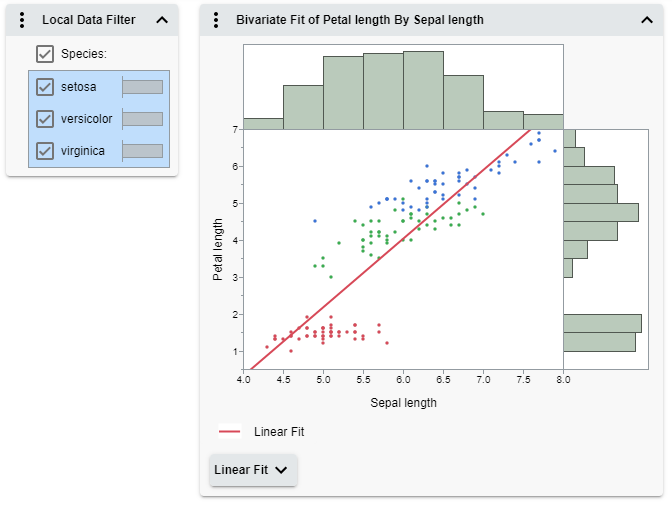
Tip: To navigate in JMP Live using a keyboard, use the Tab and Enter keys.
Find out what you can do in posts:
Open Posts
Posts appear under My Dashboard and All Posts:
|
•
|
My Dashboard: Contains all of the following types of posts:
|
|
–
|
posts that you have published
|
|
–
|
posts that people that you follow have published
|
|
–
|
posts published to groups that you are a member of
|
|
•
|
Bookmarks: Contains posts that you have bookmarked
|
|
•
|
All Posts: Contains everything from My Dashboard and all public posts (that are shared with everyone)
|
Click a post to open it. If there is only one post, it opens directly. If there are several posts in a folder, click the folder to open it, then click the post that you want to see. You can use the navigation icons to move to the next, previous, first, or last post in the folder.
See Data Values or Descriptions
In a graph or a report, point your cursor or tap on a data point or a calculation to see its values or description.
Note: To open or close reports and graphs, click or tap the arrow to the right of the title.
Figure 1.3 See Data Point’s Values
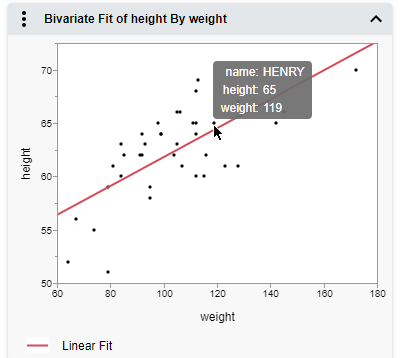
Figure 1.4 See Explanation of a P-Value Calculation

Select Data
How you select data in a graph (points, bars, and so on) depends on whether you are on a computer or a mobile device. The default mode is to select a single data point. If you want to select multiple data points:
|
•
|
On a computer, press Shift then select the data points.
|
|
•
|
On a mobile device, tap the multiple selection icon and then select the data points.
|
|
On a computer
|
On a mobile device
|
|
|---|---|---|
|
Select or deselect a single data point
|
Click a data point.
|
Tap
 then tap a data point. then tap a data point. |
|
Select or deselect multiple data points
|
Hold down the Shift key and click multiple data points.
|
Tap
 then tap multiple data points. then tap multiple data points. |
|
Identify a single data point
|
Point to a single data point.
|
Tap
 then tap a data point. then tap a data point. |
|
Select data points by brushing
|
Click and drag a rectangle over data points. Click and drag in the center to move the rectangle, or drag the corners to resize it.
|
Tap
 then draw a rectangle over the data points. Drag the center to move the rectangle, or drag the corners to resize it. then draw a rectangle over the data points. Drag the center to move the rectangle, or drag the corners to resize it. |
See Linked Data
If your JMP report contains multiple graphs, data in all graphs are linked. So if you select data, it is highlighted in all associated graphs.
Figure 1.5 Select Data in Linked Graphs
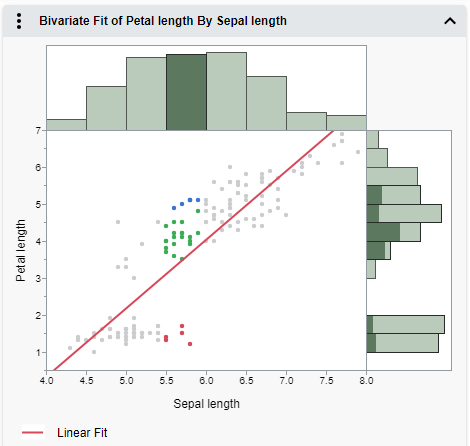
In this example, a histogram bar in the top graph is selected. The corresponding rows are highlighted in the scatterplot and in the marginal histogram.
Exclude and Hide Data
Once you have selected data, you can exclude it from report calculations and hide it in graphs. Reports and graphs automatically update.
Figure 1.6 Report Menu Options

To exclude and hide data, use the options in the More  menu on the right:
menu on the right:
Note: If the report contains a Local Data Filter, most of these options do not appear, since you use the Local Data Filter instead.
|
•
|
Exclude and Hide Selected Rows: Excludes and hides selected data.
|
|
•
|
Include and Show All Rows: Includes and shows any excluded or hidden data.
|
|
•
|
Invert Row Selection: Changes the current selection to the deselected data.
|
Additional Report Options
The More menu on a report can also contain these options:
|
•
|
Display Log Messages: Shows messages from the server and any unexpected conditions from the client.
|
|
•
|
Themes: Changes the page appearance. See Change the Theme.
|
|
•
|
Share: (Appears on small or mobile browser windows only; otherwise, appears on the toolbar as the Share icon
|
|
•
|
Bookmark/Unbookmark: (Appears on small or mobile browser windows only; otherwise, appears on the toolbar as the Bookmark icon
|
|
•
|
Delete post: (Appears only on posts that you own or if you are an administrator) Deletes the post. See Delete Posts.
|
|
•
|
Flag as inappropriate: Flags the post as inappropriate. See Flag Posts or Users.
|
Filter Data
If the original JMP report included a Local Data Filter, you can use the filter to focus on specific data and see the impact on graphs and reports.
Figure 1.7 Filter Data in Graphs
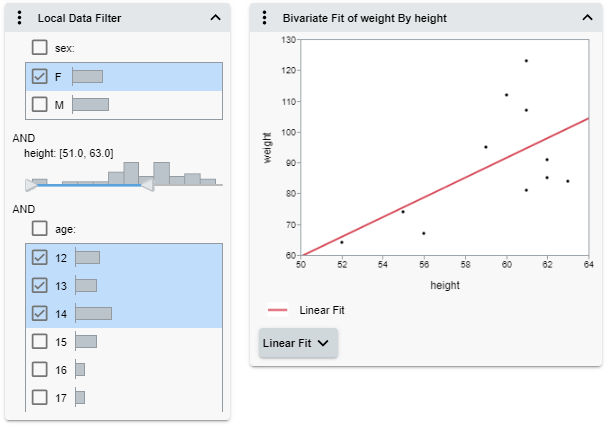
In this example, the filter choices are showing only females between 51 and 63 inches tall who are between the ages of 12 and 14.
Local Data Filter Options
Conditional Filtering
Limits the options in the Local Data Filter by condition. For more information, see Using JMP.
Note: This option does not appear if there is more than one OR group, or if the columns are not hierarchical.
Invert filter
Inverts currently selected filters.
Select filtered rows in graphs
Selects all filtered rows in graphs.
Show filtered rows in graphs
Shows all filtered rows in graphs.
Include filtered rows in calculations
Only filtered rows are included in report calculations.
Modify Graphs
Use the options in the More  menu next to a report to customize graph elements.
menu next to a report to customize graph elements.
 menu next to a report to customize graph elements.
menu next to a report to customize graph elements.
Figure 1.8 Change the Marker Size
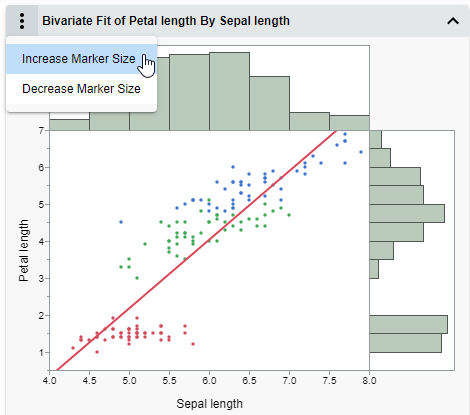
The options in this menu can vary depending on the type of graph or JMP platform. For example:
|
•
|
In scatterplots and histograms, you can change the marker size.
|
|
•
|
In profilers, you can reset the profiler to its original state, or re-scale the vertical axis to include the response.
|
|
•
|
In data filters, you can choose how you want to filter data.
|
|
•
|
In bubble plots, you can change the appearance of the bubbles.
|
Change the Theme
To change the page appearance, at the top right, click More  > Themes.
> Themes.
Figure 1.9 Change the Page Theme
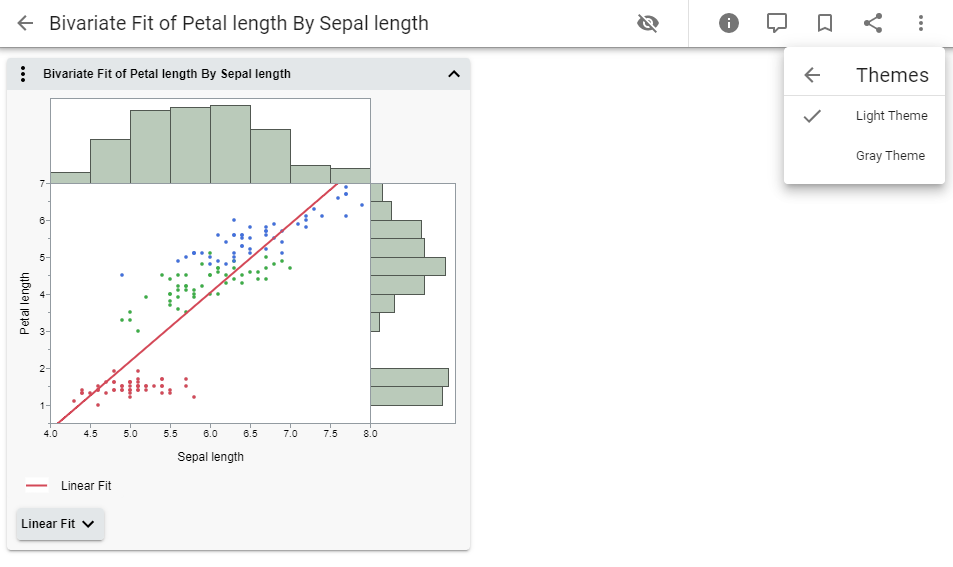
Edit Posts or Access Details
To change the title, description, sharing settings, and more on a post that you created:
|
•
|
From a post thumbnail, click More
|
|
•
|
From within your post, click Details
|
Tip: If you want to add a link to a website in the report description, you can use these HTML tags: <a href= "target">, <b>, <em>, <i>, <strong>, and <u>.
To access details about someone else’s post:
|
•
|
From a thumbnail, click More
|
|
•
|
Within someone’s post, click Details
|
You can see publishing details and comments. You might also be able to download the associated data table or copy a JSL script that re-creates the report.
Note: The associated data table and a JSL script might not appear depending on the post’s settings.
Figure 1.10 Edit a Post’s Details
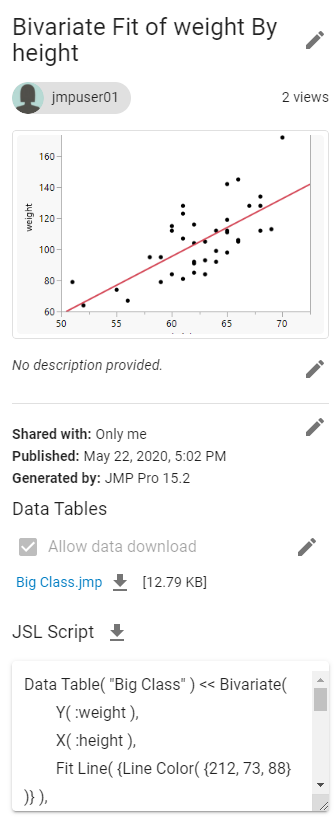
Comment on Posts
In JMP Live, you can add comments to stand-alone posts or to a folder containing several posts. You can see how many user comments are on a post in the thumbnail next to the Comments icon  .
.
Note: In addition to user comments, you might also see system comments, which are mainly informative. System comments are not included in the comment count.
To see or add comments to a post or folder, proceed as follows:
|
1.
|
Click a post or folder to open it.
|
Note: In a folder, you cannot comment on individual posts, but you can comment on the entire folder.
|
2.
|
Click
|
Any existing comments appear.
|
3.
|
Click in the Write your comment here box and enter a new comment. To respond to an existing comment, click Reply and enter a comment.
|
Tip: In addition to text, you can use basic HTML, such as bold (<b> or <strong>), italics (<i> or <em>), preformatted (<pre>), or underline (<u>). You can also use markdown, such as headings (#, ##, etc.), bold (**text**), italics (*text*), and more.
|
4.
|
Click Submit.
|
|
5.
|
(Optional) To edit or delete a comment, click More
|
If someone adds, deletes, or replies to a comment on a post that you own, you will get a notification (unless you turned off notifications for comments).
Bookmark Posts
If you want to easily access a stand-alone post or a folder containing several posts, you can bookmark it in JMP Live.
Note: In a folder, you cannot bookmark individual posts, but you can bookmark the entire folder.
To bookmark a stand-alone post or folder, click Bookmark  or
or  > Bookmark. To see all your bookmarked posts and folders, at the top, click Bookmarks.
> Bookmark. To see all your bookmarked posts and folders, at the top, click Bookmarks.
Figure 1.11 Bookmarks Page
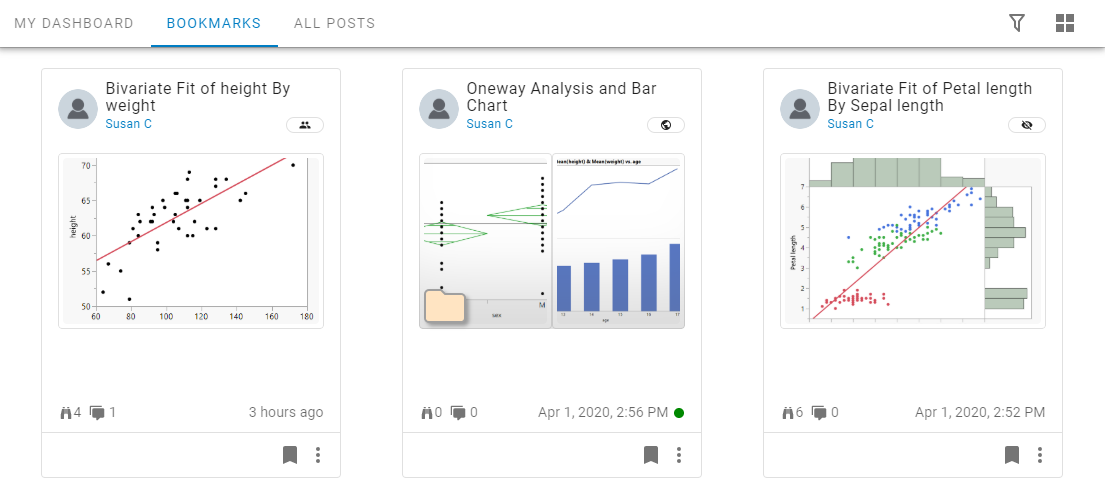
Tip: On the Bookmarks page, updated posts have a green dot next to their time stamp. After you view the post, the green dot disappears.
Delete Posts
To delete a post that you created:
|
•
|
From a post thumbnail, click More
|
|
•
|
From a post, click More
|
Figure 1.12 Delete a Post from a Post
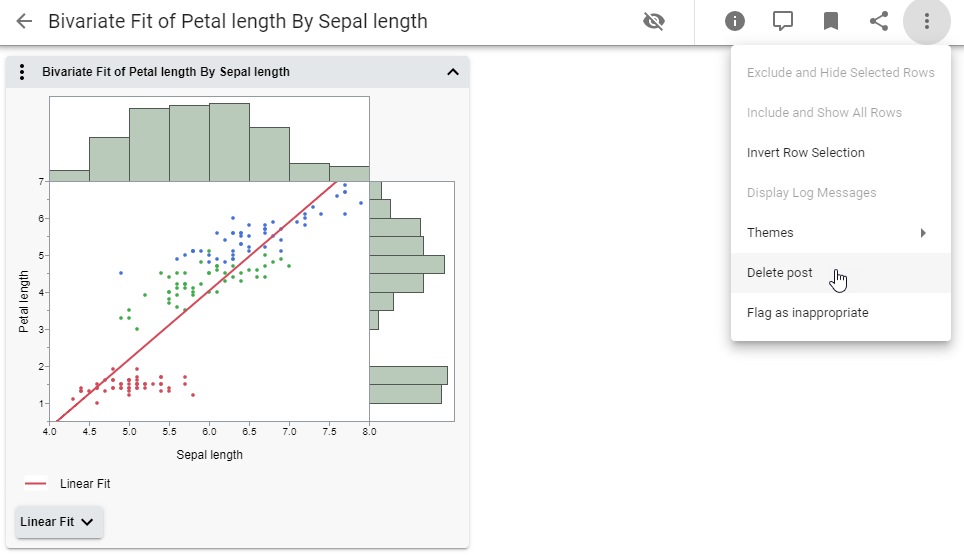
Share Posts
When you create a post in JMP, choose how you want to share it. You can keep the post private, share it with everyone, or share it with specific groups. You can change the sharing option in JMP Live.
Change How a Post is Shared
|
1.
|
Open your post.
|
|
2.
|
Click Details
|
|
3.
|
Next to Shared with, click Edit
|
|
4.
|
Select an option.
|
Tip: To stop sharing a post, set the option to Only Me. You can also quickly stop sharing a post with groups from a post thumbnail by clicking  > Stop sharing with groups.
> Stop sharing with groups.
|
5.
|
Click Save.
|
Share Posts on Social Media
To share a post on social media or using a link, click Share  or
or  > Share.
> Share.
You can share a post in any of these ways:
|
•
|
On social media: such as Facebook, Twitter, LinkedIn
|
Note: These options do not appear if your administrator has disabled them.
|
•
|
Email a link
|
|
•
|
Copy a link
|
|
•
|
Copy embedded HTML code (for a web page)
|
Figure 1.13 Sharing Options
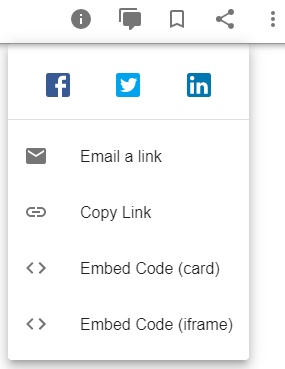
Note: If you are sharing your own post, and it is private (only you can see it), you will not see all of these options. You must first share your post with everyone to see these options.
Flag Posts or Users
If you think a post or user profile contains inappropriate content, you can flag it to the administrator:
|
1.
|
Do one of the following actions:
|
|
–
|
To flag a post: On a post thumbnail or from a post, click More
|
|
–
|
To flag a user profile: From a user profile, click More
 > Report User. > Report User. |
|
2.
|
(Optional) Add comments to explain the issue.
|
|
3.
|
Click Submit.
|
Here is what happens when a post or user profile is flagged:
|
1.
|
JMP Live administrators determine whether a flagged post should be cleared (the flag removed), hidden, or removed, and whether a flagged user profile should be cleared or hidden.
|
|
2.
|
If the administrator hides or removes a flagged post, or hides the flagged user profile, the owner of the flagged post or the flagged user is notified (if they have not turned off notifications for flags). For hidden posts or users, the owner or user can attempt to fix the problem and let the administrator know. The administrator can then reinstate the post or user if they approve.
|
Manage Notifications
In JMP Live, depending on your notification settings, you might be notified when these things happen:
|
•
|
someone new starts following you
|
|
•
|
someone adds, deletes, or replies to a comment on one of your posts
|
|
•
|
a post that you bookmarked is updated
|
|
•
|
a request that you made to join a group is approved or denied, or you are added or removed from a group
|
|
•
|
someone requests to join a closed group that you are an administrator of
|
|
•
|
someone flags a post that you created or flags your user profile
|
|
•
|
an administrator deletes one of your posts, or a folder that includes one of your posts, or if one of your posts is removed from a group
|
To see your notifications, click Notifications  . From here, you can perform the following actions:
. From here, you can perform the following actions:
|
•
|
Click a notification to take you to its source. For example, if someone comments on your post, the post opens so that you can see the comment.
|
|
•
|
Click See All to see all notifications in a larger window. From here, you can do the following:
|
|
–
|
Click Mark All as Read
|
|
–
|
Click Clear All
|
|
–
|
Click More
|
|
–
|
Click Settings
|
Manage Notification Settings
On the Notification Settings page, you can choose which types of notifications you want to receive and how often you want to get email notifications.
|
•
|
Stop receiving a notification of a certain type: Under On JMP Live, click Off.
|
|
•
|
Change how often you get email notifications: Under Email, choose a time period.
|
Figure 1.14 Example of JMP Live Notification Settings
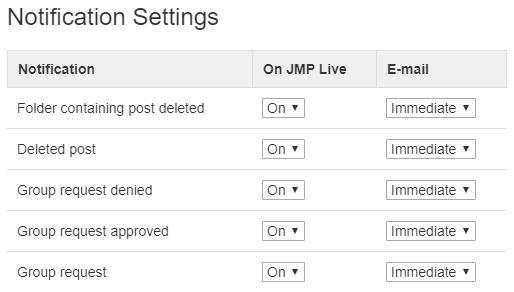
Search for People, Posts, or Groups
You can search JMP Live in these ways:
|
•
|
To search all of JMP Live, enter a name or keyword in the search box at top right.
|
|
•
|
To filter posts on the Home pages, click Filters
|
Figure 1.15 Search Options (JMP Live and JMP Public)
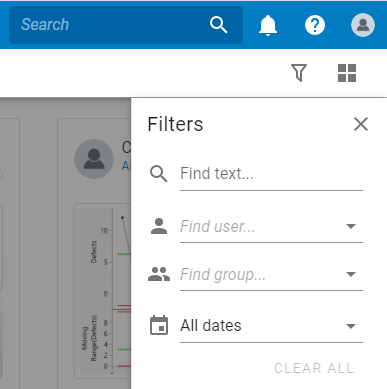
Filter Your Search
To use filters, depending on where you want to search, go to Home > My Dashboard, Bookmarks, or All Posts.
|
•
|
To find all posts from a user or group, enter a user name or group name in the Find user or Find group box. Suggestions appear as you type.
|
|
•
|
To search by a keyword in a post title, enter a word into the Find text box.
|
|
•
|
You can further refine your search by restricting the date.
|
|
•
|
To clear your search, click the x next to a user or group name, or clear other fields by clicking Clear Filters.
|
Follow Someone
If you follow someone, their posts appear on your Dashboard.
Figure 1.16 Follow Someone
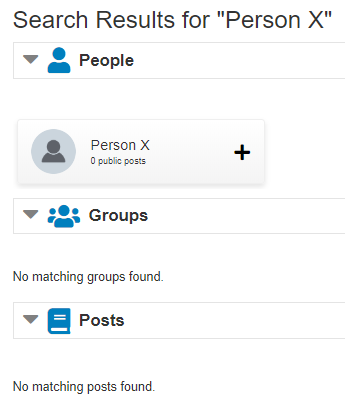
To follow someone, perform one of these actions:
|
•
|
Next to their name in the search results, click Follow
|
|
•
|
Click a person’s name to go to their user profile, and then click Follow.
|
Edit Your Profile
|
1.
|
At the top right, click your user icon > My Profile.
|
|
2.
|
Click Edit.
|
|
3.
|
Change your picture, display name, or preferred language. Depending on the authentication method, you might also be able to change your password.
|
|
4.
|
If you want to use JSL to create and publish JMP Live reports, you need an API key. Click Generate API Key and make a note of your key. For details, see Get an API Key.
|
|
5.
|
Click Save.
|
JMP Live Groups
There are different types of groups in JMP Live:
|
•
|
Personal groups: Users and administrators can create personal groups. Only people that you add to a personal group can see the group and its posts. Personal groups can be owned by the creator of the group, or by a member that you specify as an administrator of the group.
|
|
•
|
Open, Closed, or Hidden groups: Only administrators can create these types of groups.
|
|
–
|
Open: Anyone can find the group, join the group, and see the posts and members.
|
|
–
|
Closed: Anyone can find the group, but only members can see the posts and members. People can request to join the group.
|
|
–
|
Hidden: Only members can find the group and see posts and members.
|
On the Groups page, you see My Groups or All Groups:
|
•
|
My Groups: Shows all groups that you are a member of.
|
|
•
|
All Groups: Shows all groups that you are a member of and all open and closed groups that you can join or ask to join.
|
|
•
|
You can also filter by group type in the All types menu.
|
Figure 1.17 My Groups Page

When you add someone to a group, they are added automatically. They can choose to leave the group by hovering over the Joined button and clicking Leave.
Create JMP Live Groups
|
1.
|
Click Groups.
|
|
2.
|
Click Create Group.
|
Figure 1.18 Create New User Group
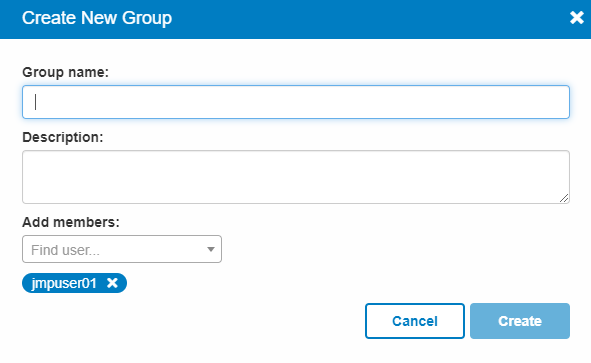
|
3.
|
Name the group.
|
|
4.
|
(Optional) Add a group description.
|
|
5.
|
Click Find user.. and type user names to add members.
|
Clickable suggestions appear as you type.
|
6.
|
Click Create.
|
Share JMP Live Posts with Groups
When you publish a report from JMP, you can share it with a group. Or, you can share a published post with a group from JMP Live.
|
1.
|
Click Home > My Dashboard to see your posts.
|
|
2.
|
Open the post that you want to share.
|
|
3.
|
Click Details
|
|
4.
|
In the Shared with section, click Edit
|
|
5.
|
Click Groups and select the groups that you want to share with.
|
Tip: To stop sharing a post that you own with a group, click  and deselect the check box of the groups you no longer want to share the post with.
and deselect the check box of the groups you no longer want to share the post with.
 and deselect the check box of the groups you no longer want to share the post with.
and deselect the check box of the groups you no longer want to share the post with.|
6.
|
Click Save.
|
The post appears on the group page and on the group members’ Home pages.
Add Members
|
1.
|
Click Groups > My Groups.
|
|
2.
|
Click the name of the group that you want to add members to.
|
|
3.
|
Click More
 > Add members. > Add members. |
|
4.
|
Type user names to add members.
|
Clickable suggestions appear as you type.
|
5.
|
Click Submit.
|
Remove Members
|
1.
|
Click Groups > My Groups.
|
|
2.
|
Click the name of the group that you want to remove members from.
|
|
3.
|
Click Manage Group.
|
Note: You must be an administrator of the group to see this option and add members.
|
4.
|
Click the row (not the Display Name) containing the names of the members that you want to remove.
|
|
5.
|
Click Delete
|
Change Member Permissions
|
1.
|
Click Groups > My Groups.
|
|
2.
|
Click the name of the group that contains the members whose permissions you want to change.
|
|
3.
|
Click Manage Group.
|
Note: You must be an administrator of the group to see this option and remove members.
|
4.
|
Click Edit Permissions.
|
|
5.
|
Select the check boxes to set these permissions:
|
|
–
|
Can Publish: Member can publish posts to the group.
|
|
–
|
Can Remove Posts: Member can remove posts from the group. Removing a post makes the post visible to only its original owner.
|
|
–
|
Group Admin: Member is a group administrator. Administrators can add or remove members from the group, change member permissions, and delete posts from the group.
|
|
6.
|
Click Save.
|
Edit Groups
|
1.
|
Click Groups > My Groups.
|
|
2.
|
Click the name of the group that you want to edit.
|
|
3.
|
Click More
 > Edit Group. > Edit Group. |
|
4.
|
Update the group details.
|
|
5.
|
Click Save.
|
Delete Groups
|
1.
|
At the top of the JMP Live web page, click Groups.
|
A list of any groups that you are a member of appears in My Groups.
|
2.
|
Click the group name.
|
|
3.
|
Click More
 > Delete Group. > Delete Group. |
|
4.
|
Click OK.
|
When you delete a group, posts shared with the group are not deleted:
|
•
|
If the post is shared with the deleted group only, it becomes private to the owner of the post.
|
|
•
|
If the post is shared with other active groups, it is removed only from the deleted group.
|